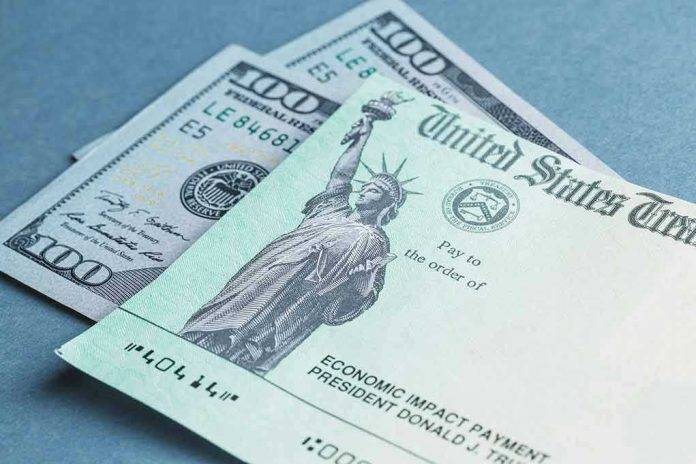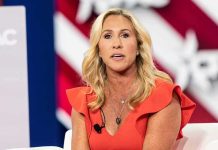
Trump’s pledge to send $2,000 “tariff checks” to Americans by 2026 is disrupting political norms, testing the boundaries of economic logic, and daring Congress to gamble on an unprecedented fiscal experiment.
Story Snapshot
- Trump allies are lobbying Congress to approve $2,000 payments to Americans, funded entirely by tariff revenue.
- The plan’s feasibility is questioned by economists, legal experts, and budget analysts across the spectrum.
- Revenue shortfalls, inflation risks, and constitutional constraints make the proposal a lightning rod for debate.
- The initiative could reshape political campaigns, federal budgeting, and America’s economic posture if it advances.
Trump’s $2,000 Tariff Check Gambit: Dollars, Drama, and Doubts
Tariffs have long served as a tool for American policymakers to protect domestic industries or fund the government, but no modern leader has tried to convert tariff revenue into direct, campaign-promised checks for voters. By proposing $2,000 “tariff dividend” payments, Donald Trump is betting that a populist twist on trade policy can jumpstart his political momentum and jolt a divided Congress into action. Trump’s pitch is simple: instead of borrowing more or hiking taxes, he claims the U.S. can finance direct aid to households solely from taxes on foreign imports, starting in “mid 2026.”
The mechanics of this plan are anything but simple. Congress, not the President, controls the federal purse and must pass legislation to enable such payments. Lawmakers have shown little appetite for proposals that hinge the nation’s social safety net on volatile trade revenues. Meanwhile, economists and budget analysts are pounding the table with warnings: the math doesn’t work. Annual tariff revenue is projected at $200–300 billion, a far cry from the $600 billion needed to fund $2,000 checks for most Americans. Any attempt to bridge this gap would require either draconian hikes in tariffs—risking trade wars and higher consumer prices—or massive cuts elsewhere in the federal budget.
Congressional Authority and Constitutional Hurdles Stand in the Way
Legal experts point out that, under the Constitution, Congress holds exclusive authority over federal spending. No executive order, no matter how forceful, can conjure up $2,000 checks without legislative approval. The last time Congress flirted with a tariff-funded rebate—during the 2018 trade standoff with China—a $600-per-family proposal fizzled without even reaching a vote. The current political climate is even more fractious, with fiscal hawks warning of runaway debt and progressives denouncing tariffs as a hidden tax on working families. For the plan to move forward, the House and Senate would need to muster bipartisan support, reconcile competing interests, and withstand intense scrutiny from budget watchdogs.
Trump’s promise is now a live wire in Washington, electrifying some allies while leaving others wary of its political and economic blowback. Congressional leaders have yet to introduce enabling legislation, and committee chairs are noncommittal, citing concerns over fiscal responsibility and legal precedent. The executive branch can suggest, but Congress ultimately disposes. Allies are working feverishly to sway the debate, but the odds remain steep.
Economic Realities: Revenue Gaps, Inflation Fears, and Ripple Effects
John Ricco of the Yale Budget Lab distills the expert consensus: “It’s clear the revenue coming in would not be adequate.” The numbers don’t lie. Even if tariffs were doubled overnight, the windfall would still lag far behind the cost of universal $2,000 checks. Erica York of the Tax Foundation echoes this skepticism, noting that the plan’s arithmetic “just doesn’t check out.” Critics warn that raising tariffs to fill the gap would increase prices for American consumers, effectively clawing back much of the promised benefit and possibly stoking inflation.
Retailers and importers would also face higher costs, some of which would inevitably be passed on to shoppers at the checkout line. The ripple effects could stretch beyond the consumer, roiling financial markets and creating fresh uncertainty in sectors already battered by global supply chain disruptions. For low- and middle-income Americans, the checks might offer short-term relief, but experts caution that inflation could erode their value rapidly—undercutting the very boost the program aims to provide.
Campaign Calculus and the Future of Populist Economics
For Trump and his allies, the proposal serves multiple ends: it’s a headline-grabbing campaign promise, a rebuke to critics of past stimulus efforts, and a bold attempt to reframe trade as a direct benefit to voters. The political logic is clear—few things energize a base like the promise of cash in hand. Yet this gambit also raises uncomfortable questions for fiscal conservatives, who must reconcile support for tax cuts and deregulation with a plan that could balloon the deficit and upend traditional budgeting norms.
As the debate unfolds, Americans are left to ponder whether this is visionary populism or fiscal fantasy. The proposal’s fate hangs in the balance, dependent on the willingness of Congress to rewrite long-standing rules and on the American public’s appetite for risk. One thing is certain: the $2,000 tariff check plan has already succeeded in one respect—it has forced the nation to confront fundamental questions about how, and for whom, economic policy should work.













